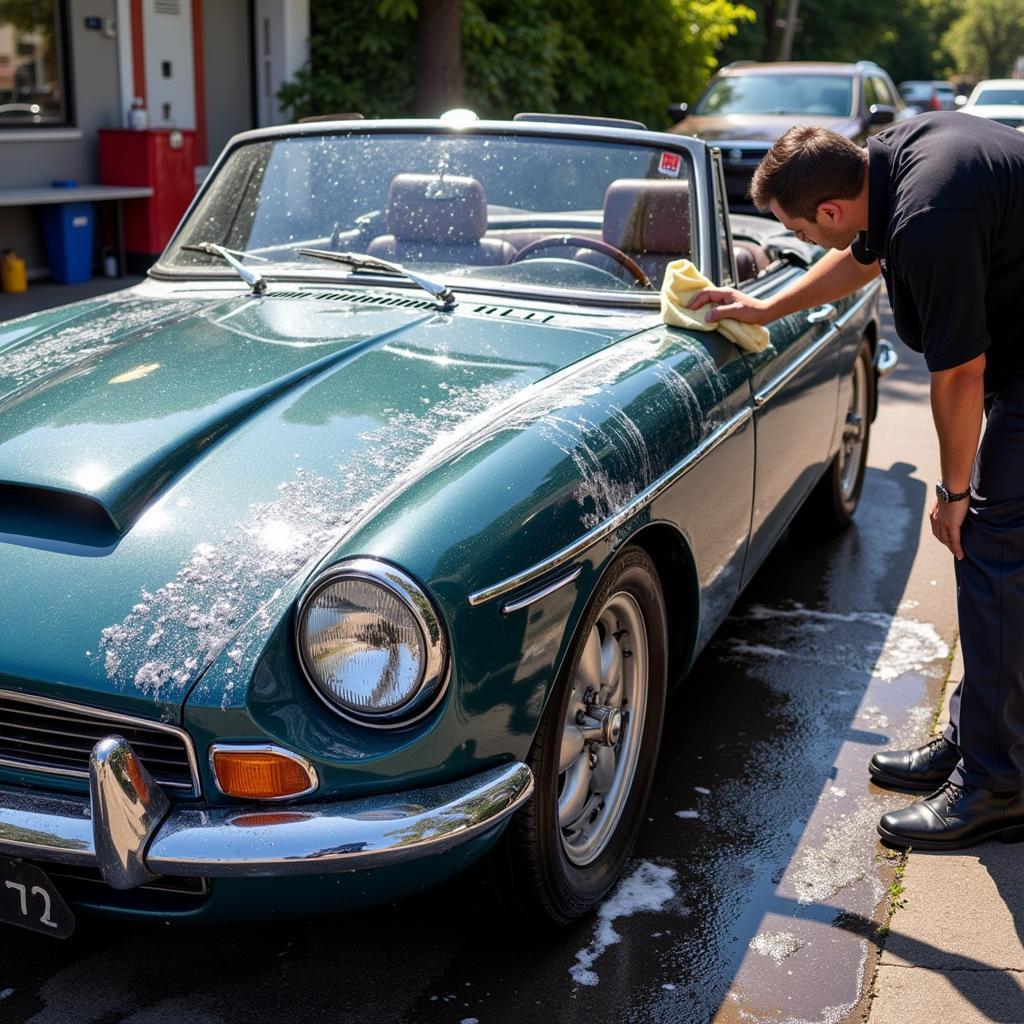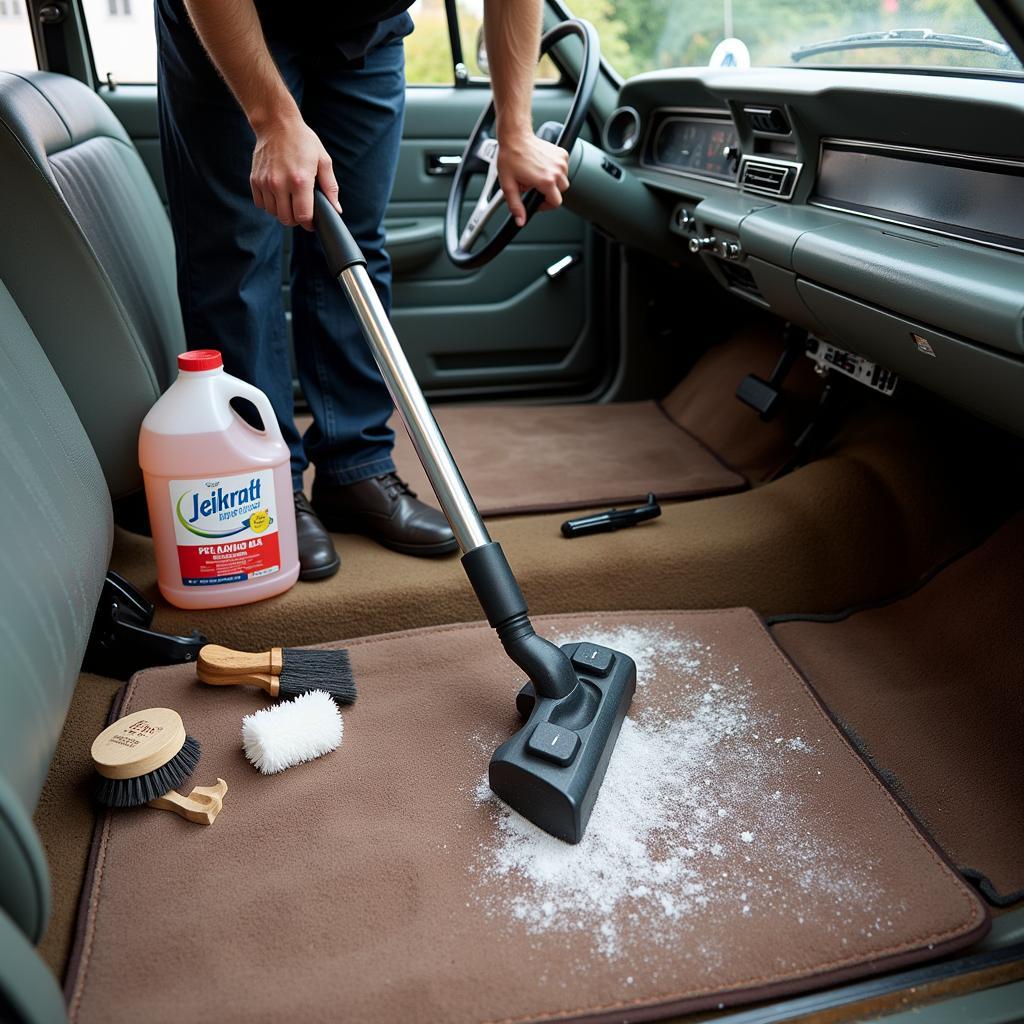Detailing an old car can bring it back to its former glory, or at least a respectable approximation of it. It’s more than just a wash and wax; it’s a thorough rejuvenation process. Whether you’re prepping for a sale, restoring a classic, or simply want your trusty vehicle to look its best, this guide will walk you through How To Detail An Old Car effectively.
 Detailing the exterior of a classic car involves washing, polishing, and waxing to restore its shine.
Detailing the exterior of a classic car involves washing, polishing, and waxing to restore its shine.
Assessing the Condition of Your Old Car
Before diving in, carefully inspect your car. Note any rust, paint damage, faded trim, or interior wear and tear. This assessment will help you determine the necessary products and techniques. Don’t underestimate the power of a good wash! Even heavy dirt and grime can mask the true condition of the paint underneath.
Washing and Decontamination: The Foundation of Detailing
Start with a thorough wash using a pH-neutral car shampoo. This is crucial for removing loose dirt and preparing the surface for decontamination. Do car detailers clean mold? Absolutely, and mold removal is a key part of detailing, especially for older cars that might have been exposed to moisture. After washing, use a clay bar or iron remover to pull out embedded contaminants like iron particles and tree sap. This step will leave your paint feeling incredibly smooth.
Paint Correction: Restoring the Shine
Older cars often have swirl marks, scratches, and oxidation. Paint correction involves using polishing compounds and a machine polisher to remove these imperfections and restore the paint’s clarity. This is a more advanced technique and requires careful attention to avoid further damage. However, the results on an old car can be dramatic. For deeper scratches, wet sanding might be necessary, but it’s best left to professionals if you’re not experienced. Similar to do all cars get detailed before being sold at dealerships, many private sellers opt to detail their old cars before putting them on the market to increase their appeal and value.
Protecting the Paint: Sealing and Waxing
Once the paint is corrected, it’s essential to protect it. A sealant provides a durable layer of protection against UV rays, environmental contaminants, and minor scratches. Waxing adds another layer of protection and enhances the gloss. There are various types of waxes available, each offering different levels of durability and shine.
Interior Detailing: Reviving the Cabin
 Cleaning the interior of an old car involves vacuuming, shampooing carpets and upholstery, and conditioning leather.
Cleaning the interior of an old car involves vacuuming, shampooing carpets and upholstery, and conditioning leather.
A clean interior is just as important as a gleaming exterior. Start by thoroughly vacuuming the carpets, seats, and dashboard. Shampoo the carpets and upholstery to remove stains and odors. Leather seats should be cleaned and conditioned to prevent cracking and fading. Don’t forget to clean the smaller details like air vents, door panels, and the steering wheel. Just like knowing can car detailing remove mold, understanding how to clean and condition these various materials is key to a successful interior detail.
Addressing Common Issues in Old Cars
Older cars often have specific issues that require extra attention. These can include rust spots, faded trim, cracked dashboards, and brittle weather stripping. There are products specifically designed to address these issues, such as rust converters, trim restorers, and vinyl protectants.
How Long Does it Take to Detail an Old Car?
Detailing an old car can take anywhere from a few hours to several days, depending on the car’s condition and the level of detail desired. A basic detail might take a few hours, while a full restoration detail can take several days. This often aligns with the question does car detailing include mold, as addressing mold can significantly impact the time required.
Conclusion: Enjoy Your Rejuvenated Classic
Detailing an old car is a rewarding process. By following these steps, you can significantly improve its appearance and preserve its value. Remember to assess the condition, clean thoroughly, correct any paint imperfections, protect the paint, and revitalize the interior. Whether you’re a seasoned detailer or a beginner, the effort you put into detailing your old car will be well worth it. For more information on whether it’s is it worth detailing an old car, check out our dedicated article.
FAQ
- What’s the difference between washing and detailing a car?
- What are the essential tools for detailing an old car?
- How often should I detail my old car?
- Can I detail my car myself, or should I hire a professional?
- What are some common mistakes to avoid when detailing an old car?
- How can I protect my newly detailed car?
- What are the best products for detailing an old car?
Need help? Contact us via WhatsApp: +1(641)206-8880, Email: [email protected]. Our customer service team is available 24/7.

Leave a Reply